How Long Can Dogs Go Without Water? Essential Facts Every Owner Should Know
A healthy dog can go without water for about 24 hours before dehydration starts. After this point, the risks increase significantly, and serious health issues can arise beyond 72 hours. Understanding how long can dogs go without water is vital to keeping your pet healthy. This article will explore the factors influencing dehydration, signs to watch for, and ways to ensure your dog stays hydrated.
Key Takeaways
-
A healthy dog can go without water for approximately 24 hours before dehydration sets in, with severe risks occurring after 72 hours without water.
-
Dehydration can occur quickly, with signs appearing in as little as 6 to 10 hours, and can lead to serious health complications if not addressed promptly.
-
Preventing dehydration involves a comprehensive approach, including providing constant access to fresh water, monitoring water intake, and addressing environmental factors and health issues.
How Long Can Dogs Go Without Water? Essential Facts Every Owner Should Know
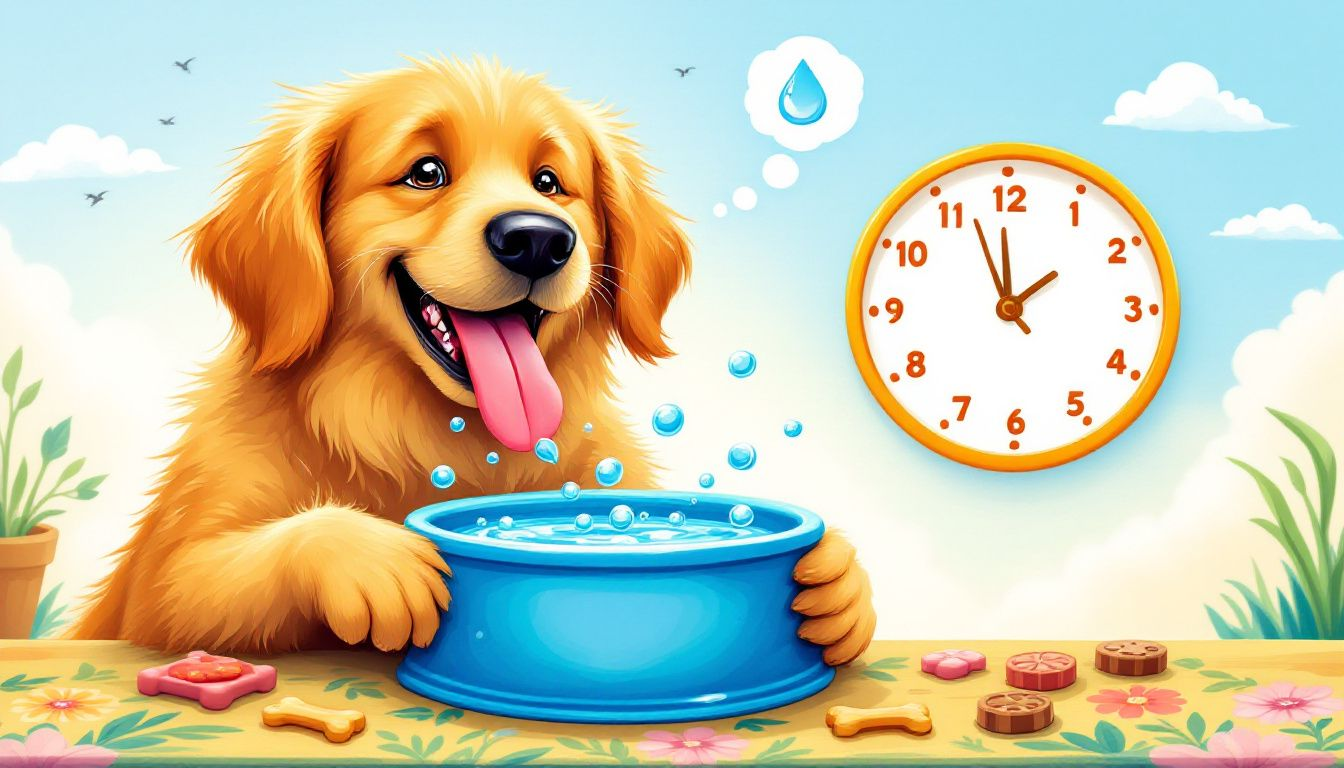
A healthy dog can typically go without water for about 24 hours before dehydration begins to set in. Beyond this point, the risks escalate significantly. After 72 hours without water, a dog’s health can be severely compromised, potentially resulting in life-threatening complications. Dog owners need to understand how long can a dog go without water to keep their pets adequately hydrated.
Several factors can influence how long a dog can go without water, including its size, age, activity level, and overall health. Larger and more active dogs may dehydrate faster, while older dogs or those with health issues might be more susceptible to dehydration.
Monitoring your dog’s water intake and providing constant access to fresh water helps prevent dehydration and maintain their health.
Introduction
Water is the essence of life, and this holds true for our canine companions as well. Hydration is not just about quenching thirst; it’s about supporting vital bodily functions that keep a dog’s body healthy and active. From aiding in digestion to regulating body temperature and cushioning joints, water plays a pivotal role in a dog’s overall well-being.
At LYX, we recognize the importance of hydration in maintaining a dog’s health. Our mission is to make hydration education accessible, entertaining, and relevant to everyday pet care. By providing scientifically crafted solutions, we empower pet parents to prioritize their dogs’ wellness.
Join us as we explore the critical aspects of dog hydration and introduce innovative solutions like the LYX Hydralicious Mix.
Critical Timeframes for Dog Hydration
A dog’s body can begin to show signs of dehydration within just 6 to 10 hours without water under normal conditions. As dehydration progresses, a dog’s blood flow and oxygen delivery to organs and tissues become restricted, leading to severe health issues. After 24 hours, the signs of dehydration become more apparent, such as dry gums and loss of skin elasticity, and health complications can start to arise.
In extreme scenarios, healthy dogs might survive without drinking water for about 3 to 5 days, but this is not without severe risks. Dehydration can lead to a range of serious health problems, including kidney failure, loss of consciousness, and even death. Dog owners must be vigilant in providing their pets with fresh water at all times.
Knowing these critical timeframes highlights the urgency of providing water to your dog. Even short periods without water can compromise a dog’s health, making it essential to prioritize regular and adequate water intake to prevent dehydration and its associated risks.
Signs Your Dog is Dehydrated
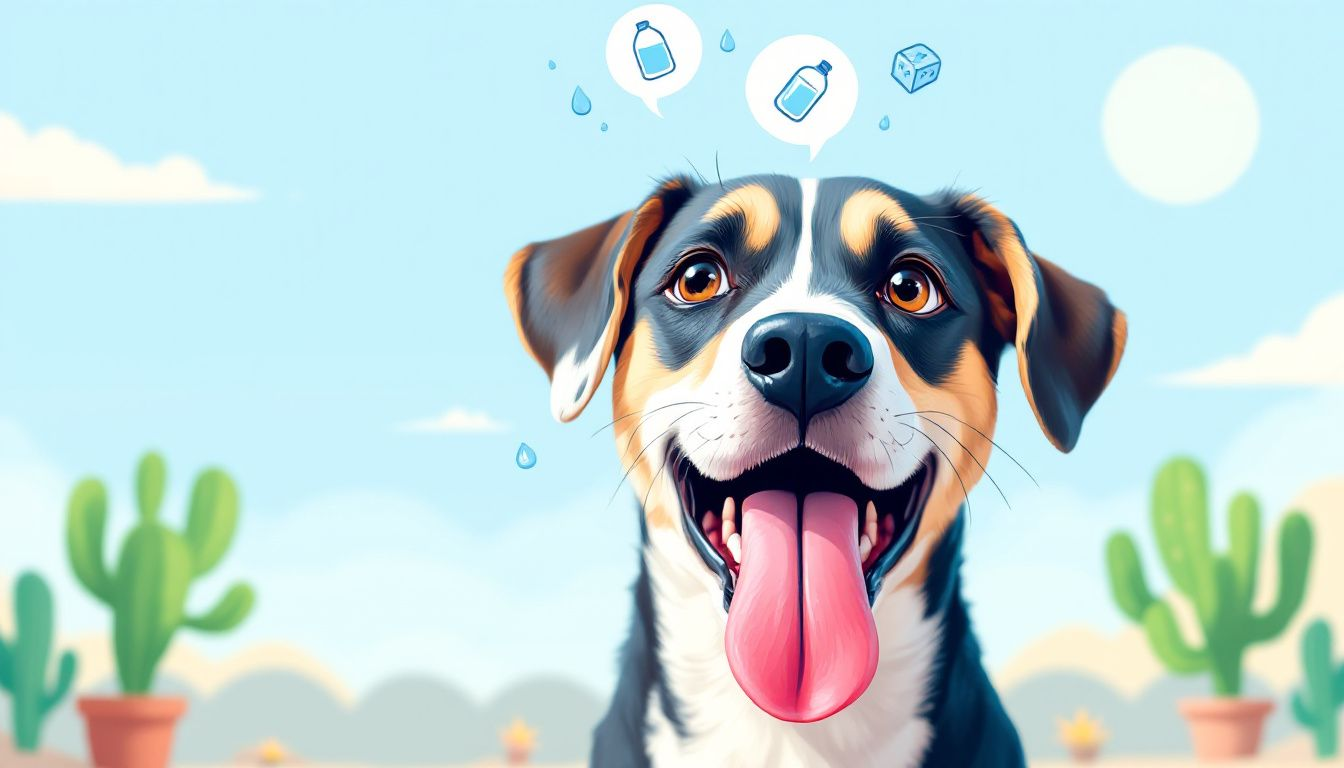
Before:
Recognizing the signs of dehydration in your dog can be crucial for timely intervention. Common indicators include lethargy, dry gums, and a loss of skin elasticity. You might also notice moist gums thick saliva, which is a clear sign that your dog is not getting enough water. These symptoms can quickly escalate, leading to more severe health problems if not addressed promptly.
After:
Recognizing the signs of dehydration in your dog can be crucial for timely intervention. Common indicators include:
-
lethargy
-
dry gums
-
loss of skin elasticity
-
thick and pasty saliva
These symptoms can quickly escalate, leading to more severe health problems if not addressed promptly.
Dehydration in dogs can result in serious health issues, including kidney failure and even death. Dog owners should be aware of these signs and take immediate steps to rehydrate their pets. Monitoring your dog’s water consumption and watching for signs of dog dehydration can help maintain their well-being.
Causes of Dehydration in Dogs
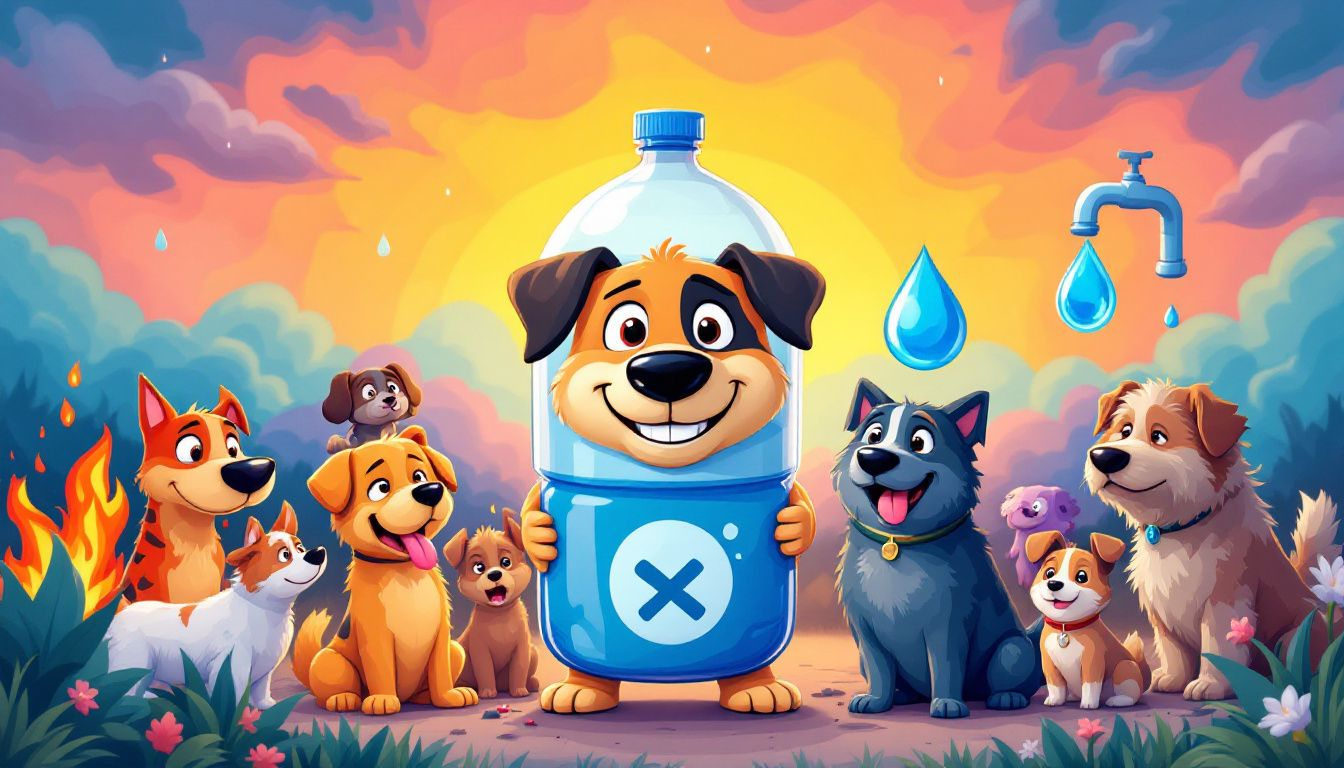
Dehydration in dogs can result from various factors, with heat exposure, excessive exercise, and illness being the most common causes. When dogs engage in intense physical activities, they lose water rapidly through panting and sweating, increasing their risk of dehydration. Additionally, illnesses such as fever, diarrhea, or injuries can significantly contribute to a dog’s dehydration.
Environmental factors also play a crucial role. Hot weather can lead to rapid water loss, making it vital for dogs to have constant access to fresh water. Dogs on dry food diets typically require more water compared to those on moist diets, as dry food can increase their overall water needs.
Underlying health issues such as stomach upset, pain, or dental problems can deter dogs from drinking water, necessitating a vet consultation. Identifying and addressing these issues promptly ensures your dog remains hydrated and healthy.
Immediate Steps if Your Dog is Dehydrated
If you notice signs of dehydration in your dog, it’s crucial to act quickly. Offering small amounts of water frequently can help mildly dehydrated dogs rehydrate without causing vomiting. You can also provide ice cubes for them to lick, which can be a gentle way to increase their fluid intake.
In cases of severe dehydration, immediate veterinary care is essential. Dogs may require intravenous fluids to effectively rehydrate and stabilize their condition. If your dog shows signs of shock or severe dehydration, do not hesitate to seek professional help quickly to prevent further health complications.
Daily Water Requirements for Dogs
A general guideline for a dog’s daily water intake is one ounce of water for each pound of their dog’s body weight. However, factors such as size, age, diet, and activity level can influence their water needs. Making sure your dog drinks enough water daily is crucial for maintaining health and preventing dehydration.
Having fresh water readily available at all times is crucial. Dogs prefer to drink clean, fresh water, and having multiple sources can encourage them to drink more. Monitoring your dog’s water intake and making adjustments based on their activity level and environmental conditions can help maintain their hydration.
Encouraging Your Dog to Drink More Water
Ensuring your dog drinks enough water can sometimes be challenging. However, there are several strategies you can employ to encourage more water intake.
Making water accessible, adding flavors, and addressing any underlying health issues can significantly improve your dog’s hydration.
Making Water Accessible
Providing your dog with access to clean, fresh water at all times is vital. This is vital for their health and well-being. Positioning a water bowl in various areas of your home can accommodate your dog’s favorite resting spots, making it easier for them to drink frequently. Using stainless steel or ceramic bowls instead of plastic ones can also encourage dogs to drink more water.
Fresh water should always be available, especially during hot weather or after exercise. Multiple water sources can help prevent dehydration and ensure your dog stays hydrated throughout the day.
Flavor Enhancements
Adding flavors to your dog’s water can make it more appealing. Low-sodium broth or unsalted tuna water can entice your dog to drink more. Incorporating such flavors can make drinking water a more enjoyable experience for your dog.
LYX Hydralicious Mix, which combines hydration support with savory flavors like chicken or beef broth, is another great option to encourage water intake. This flavorful mix not only supports hydration but also provides essential nutrients for your dog’s overall health.
Addressing Health Issues
If your dog refuses to drink water, it could be indicative of underlying health issues that require veterinary attention. Common signs of dehydration or health problems include lethargy, dry gums, or unresponsive behavior. Giving small amounts of water or ice and monitoring for symptoms like vomiting or diarrhea is essential.
Consulting a vet quickly is vital to ensure your dog’s health is not compromised. An accurate diagnosis and timely treatment can address any underlying issues and help maintain your dog’s hydration and overall health, but this information does not constitute medical advice.
Preventing Dehydration in Dogs
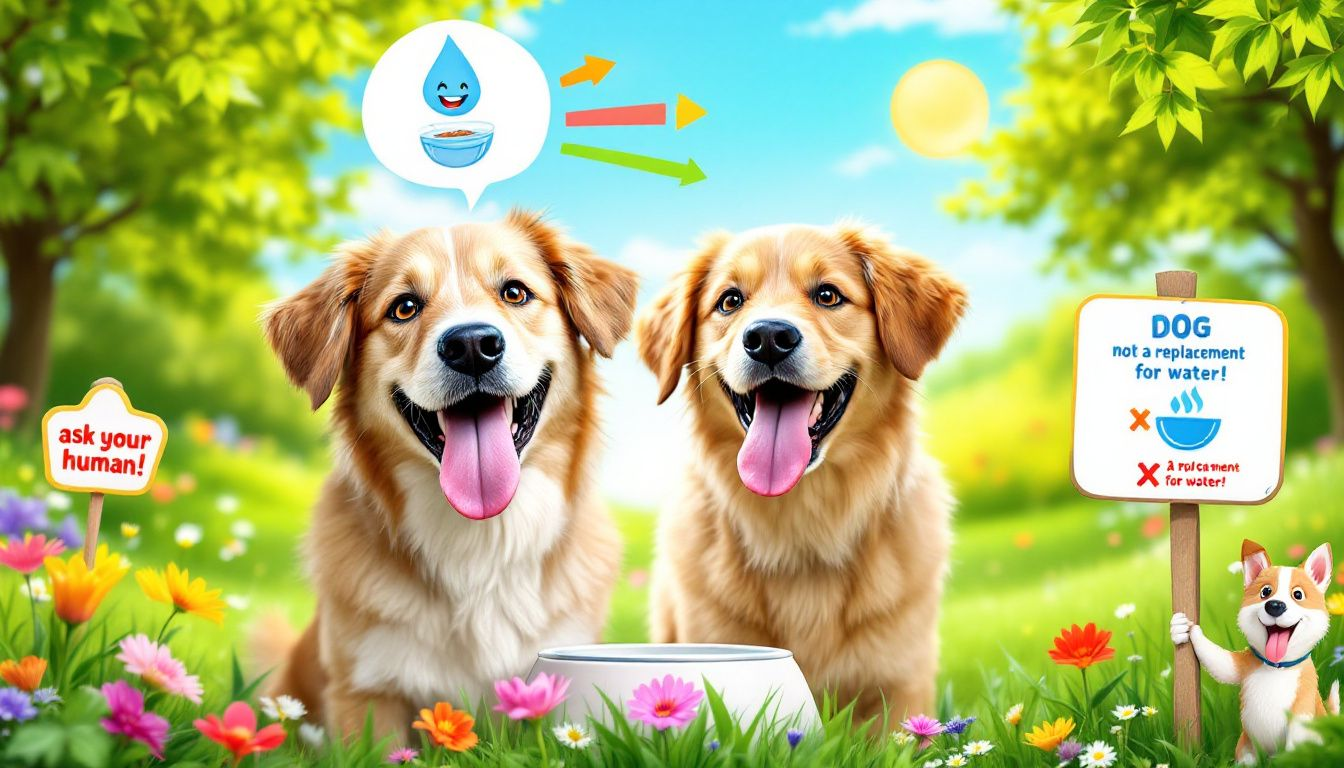
Preventing dehydration is about more than just providing water; it involves a comprehensive approach to your dog’s care. Adequate water intake helps prevent urinary tract infections and supports kidney and liver function, as well as reducing the risk of intestinal or urinary blockage. Providing fresh water, especially during hot weather or vigorous exercise, is crucial.
Environmental adjustments, such as keeping your dog in shaded areas during hot days, can help prevent heat-related dehydration. Elevated water bowls can also alleviate strain on a dog’s neck, particularly for larger breeds, making it easier for them to drink.
Regularly monitoring your dog’s hydration status and adjusting their environment and diet are key steps in preventing dehydration. Using non-slip mats around water bowls can prevent spills, especially for dogs with mobility issues.
The Role of LYX Hydralicious Mix in Dog Hydration
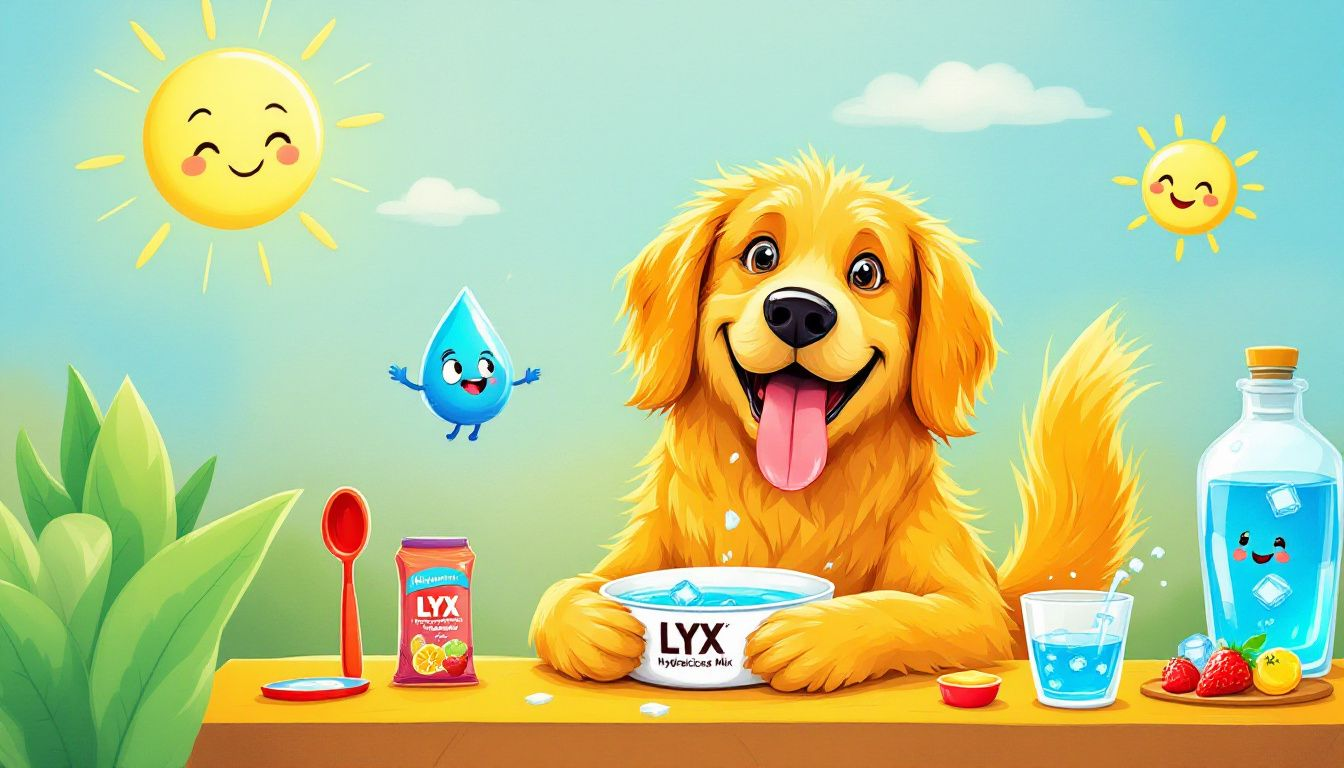
LYX Hydralicious Mix offers a unique solution for dog hydration. Its formulation ensures rapid hydration, providing faster relief than plain water. The mix contains 12 vitamins and nutrients, supporting overall wellness, anxiety, and aging.
Made with natural ingredients and free from sugars, preservatives, and artificial additives, LYX Hydralicious Mix is a healthy and flavorful way to ensure your dog stays hydrated. Its blend of coconut water and savory broths is designed to appeal to dogs, making it an effective and enjoyable hydration option.
Summary
Hydration is a fundamental aspect of maintaining your dog’s health. By understanding the critical timeframes for hydration, recognizing signs of dehydration, and taking preventive measures, you can ensure your dog remains healthy and happy. Daily water requirements should be met with fresh water, and encouraging strategies can help improve your dog’s water intake.
LYX Hydralicious Mix provides an innovative solution to support your dog’s hydration needs. Its natural ingredients and flavorful options make it an appealing choice for dogs of all ages. Prioritizing hydration with the right tools and knowledge can enhance your dog’s overall well-being.
Frequently Asked Questions
How long can a dog go without water before it becomes dangerous?
A healthy dog can safely go without water for approximately 24 hours, but severe dehydration risks emerge after 72 hours. It is crucial to ensure your dog has access to fresh water at all times to prevent health complications.
What are common signs of dehydration in dogs?
Common signs of dehydration in dogs include lethargy, dry gums, thick saliva, and decreased skin elasticity. Monitoring these signs is essential for maintaining your dog’s health.
How much water should my dog drink daily?
Your dog should drink approximately one ounce of water for each pound of its body weight daily to ensure proper hydration. This guideline helps maintain their health and well-being.
How can I encourage my dog to drink more water?
To encourage your dog to drink more water, ensure it is easily accessible, consider adding flavors such as low-sodium broth, and consult a veterinarian to rule out any health issues that may affect hydration.
What makes LYX Hydralicious Mix effective for dog hydration?
LYX Hydralicious Mix is effective for dog hydration due to its unique formulation with natural ingredients and absence of artificial additives, which appeals to dogs and encourages them to drink more water.

